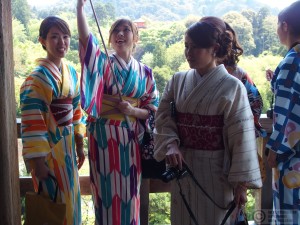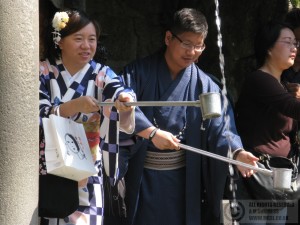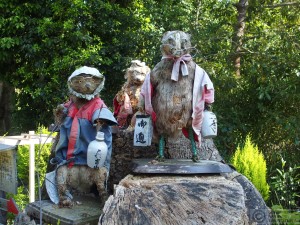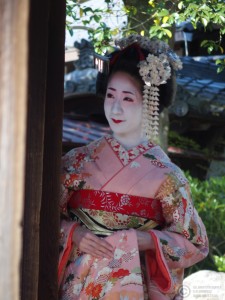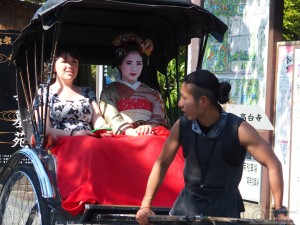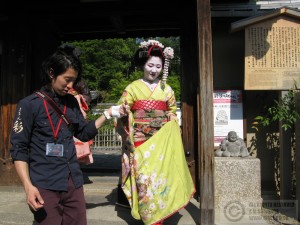Of course, with a new camera comes the need for a new case, so it was back into Bic. Taking the bus to the station served as a dry run for our departure; we needed to see how full the bus would be before we boarded one with all our luggage. At the station we switched to the bus for Kiyomizudera, and alighted with most of the other passengers to start the long, steep slog up to the temple. It was dreadfully crowded; a sunny Saturday in April probably isn’t the best time to visit. The kimono hire shops had been doing brisk business, and some of the girls had even persuaded their boyfriends to dress up in traditional robes. They do look nice. The Kyoto authorities are trying to encourage the wearing of traditional dress, even offering free bus rides to kimono wearers on certain days. But most of the wearers at Kiyomizudera were Chinese.
Kiyomizudera has two specific draws; a platform jutting out from the hillside on enormous wooden stilts, and a spring with, naturally, “special powers”. Adjacent to the platform is the main temple, and a special event was taking place: prayers for those killed in the 2011 earthquake and tsunami. Behind the main hall was a steep little hill topped with a “good luck” temple with even more fortune telling opportunities than usual.
The path led along the hillside, giving a good view of the platform construction, then down to the spring at the base of the temple. There are 3 spouts, and drinking from them is supposed to bring longevity, wisdom and love respectively (but not if you drink from all three as that would be greedy). There was a long queue of people waiting to mount the platform and stick a ladle under their spout of choice. Some members of a Chinese tour group were effectively pushing in by getting their friend on the platform to fill containers for them, but the Japanese were too polite to protest.
- Taking the waters
The main temple approach road ran straight down the hill and was lined with touristy shops; souvenirs, ice cream, pickled cucumbers on sticks. We cut down some steps to the right to pass more shops, cafés and some minor temples. There are something like 1600 temples and shrines in Kyoto, so one is never far away. We passed two women in full geisha costume, then two more being photographed, but somehow I suspected they were not the genuine article, but tourists playing dress-up.
Our route eventually took us down into Gion, the area by the river where the traditional teahouses are located. Posters were advertising the maiko dance show in the Gion Theatre: this show by trainee geisha is the only opportunity for most tourists to see geisha in action. An evening of genuine geisha entertainment costs around £1000, and you need an introduction from an established client just to to set foot in the door. It’s a dying art of course, but Kyoto still has about 100. We saw three women who we suspected might be geisha even though they were not yet made up, in their 40s perhaps, wearing very expensive looking kimono and walking very quickly and purposefully along Gion’s main teahouse street. Then later a younger geisha in full costume and white make up with elaborately styled wig. Her unornamented hair and plainer kimono suggested that here was a woman on her way to work.
- Pretend geisha
Along the riverbank many people were just sitting enjoying the sunshine. We waited for ages for a number 32 bus, but eventually gave up and hopped on a 207. It meant a longer walk to the supermarket at the other end, but at least we got a sit down in the meantime. When we eventually found the Super-Matsumoto supermarket it turned out to be the biggest and cheapest yet; it was a shame we didn’t discover it sooner. It was now dark and it took two more bus rides to get home, so we were pretty shattered.
When we turned on our tablets it was to discover the news of the terrible earthquake in Nepal. I saw the state of many of Kathmandu’s buildings last October so the destruction didn’t surprise me, but it saddened me immensely to see the pictures of the Durbar Squares in Kathmandu and Patan. Also to think of our guesthouse; the owner was so sweet and obviously tremendously proud of the Happy Home. Construction work was going on while we were there, to create more rooms. All that investment and optimism and planning for the future, and now I don’t even know if the place is still standing. Even if it is, the dent in the tourist trade will probably mean the new rooms stay empty. Most Nepalese people have so little at the best of times – it’s just so unfair.



